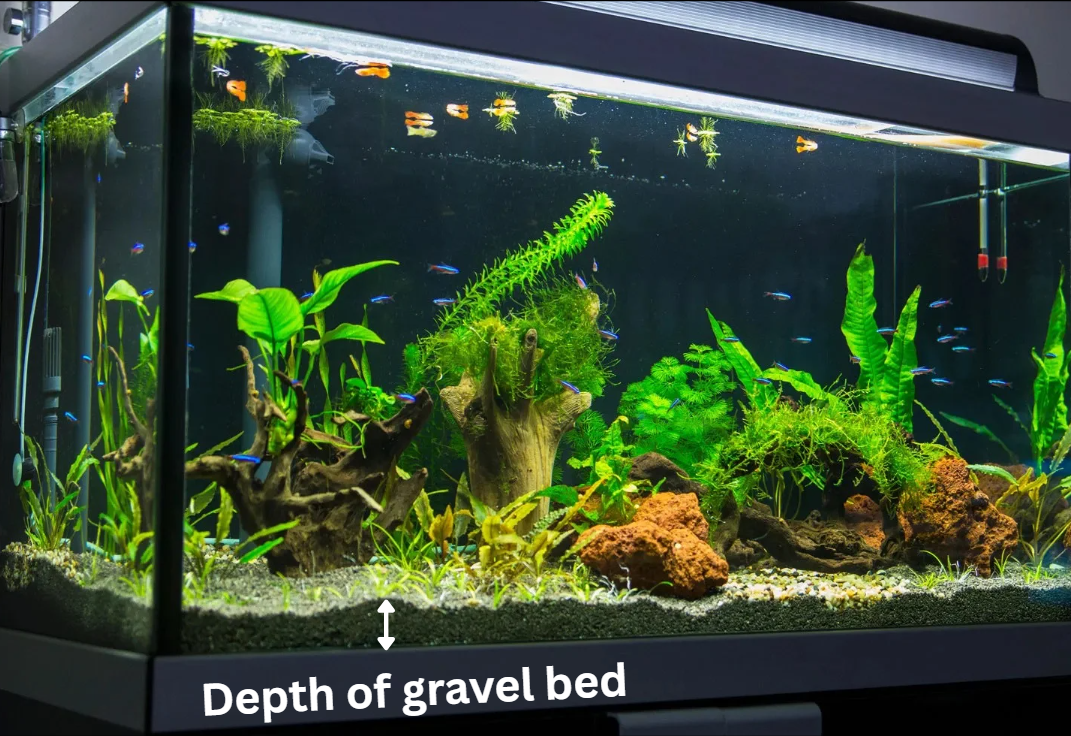Why Use a Gravel Calculator for Your Aquarium
Gravel sets the stage for everything that happens inside the aquarium. Plants anchor in it, helpful bacteria grow on it, and fish interact with it all day. If the layer is too thin, roots float free and plants weaken. If it is too thick, pockets of stale water can build up and upset the balance. Guessing the gravel needed for your aquarium leads to one of those extremes and disturbs the vibe of the whole tank.
A gravel calculator ends the guesswork. Just enter the tank’s length, width, and the depth of the gravel bed you want. The tool returns the exact amount of substrate in kilograms, pounds, or litres, taking the density of your chosen material into account.
Quick‑Start Guide to the Aquarium Gravel Calculator
- Type the length, width, and desired gravel depth in whichever unit you want.
- Pick the unit you prefer for the result.
- Adjust the depth slider to preview different scapes before a single pebble lands in the tank.
Recommended Gravel Depths for Aquarium Setups
| Tank Size | Planted Setup | Fish‑Only Setup | Shrimp & Nano Tanks |
|---|---|---|---|
| Under 40 L (10 US gal) | 4–5 cm | 3 cm | 2–3 cm |
| 40–120 L (10–30 gal) | 5–6 cm | 3.5 cm | 3 cm |
| 120–250 L (30–65 gal) | 6–7 cm | 4 cm | 3–4 cm |
| 250 L + | 7–8 cm | 4–5 cm | 4 cm |
Choosing the Right Aquarium Gravel
Gravel shapes water chemistry, anchors roots, and sets the tone for the entire aquascape. Before buying a single bag, think about grain size, hardness, and colour. Mid‑size grains (2–4 mm) usually suit most community tanks because they let water flow yet keep waste from sinking too deep.
Quartz or Silica Stone
Quartz stays chemically neutral, so it will not alter pH or hardness. Community tanks with tetras, barbs, or guppies benefit from this stability. A light surface also bounces extra light toward low‑growing plants.
Clay‑Based Plant Soil
Fired clay pellets act like nutrient sponges. Stem plants send roots through this medium quickly and show stronger colours. Give the pellets a brief rinse first; otherwise a dusty haze can cloud the water.
Polished River Pebbles
Smooth edges protect bottom dwellers such as corydoras and loaches. The extra weight pins down wood and rock, preventing hardscape shifts when fish dig or when water currents pick up. Pair with a thinner under‑layer or mix in finer grains so debris cannot slip through.
Crushed Coral or Aragonite
Ground coral slowly dissolves, raising carbonate hardness and keeping pH steady—ideal for African cichlids or many marine setups. Soft‑water species like discus prefer a gentler base.
Dark Lava Rock
Porous and lightweight, lava offers enormous surface area for beneficial bacteria. Its deep colour hides algae films and makes bright fish colours pop. Rinse thoroughly to remove dust before filling.
Match the shade of the gravel to the scene you want. Dark beds highlight neon fish, while pale sand sets off lush, green stems. Always choose products labelled “aquarium safe” and steer clear of painted pebbles that may shed toxic flakes over time.
Aquarium Gravel Density Cheat Sheet
| Gravel Type | Approx. Bulk Density (kg/m³) |
|---|---|
| Quartz or River Gravel | ≈ 1 500 |
| Clay‑Based Plant Substrate | ≈ 1 200 |
| Crushed Coral / Aragonite | ≈ 1 400 |
| Fine Sand | ≈ 1 600 |
Figures represent loosely poured, rinsed substrate. Compaction, moisture, and grain shape can shift actual density by ± 5 %. Always check the manufacturer’s label for exact values.
Pro Tips for Aquarium Gravel Layout
- Create a front‑to‑back slope. Start shallow at the front glass, then add more substrate toward the rear for depth and plant root space.
- Lock slopes in place with structure. Low retaining walls of lava rock or plastic mesh keep gravel from sliding during water changes.
- Rinse thoroughly before the first pour. A quick bucket wash removes dust that would cloud the water and clog filters.
- Cap nutrient soils with plain gravel. A 1 cm cover of quartz prevents clay from floating.
- Plant with long tweezers. Place stems without disturbing the bed for clear water.
- Vacuum in gentle passes. Lift debris while leaving beneficial bacteria intact.
Frequently Asked Questions
How much gravel do I really need?
Start with 1 lb per US gallon for a 3 cm bed. Use the calculator for exact figures using your tank’s length, width, and depth.
Will coloured gravel harm my fish?
Quality products seal pigment inside an epoxy coating, so they stay inert. Rinse until water runs clear; if it clouds, return the bag.
Can I mix sand and gravel?
Yes, but layers may shift. Keep each layer ≤ 1 cm or separate with mesh to maintain circulation.
Does gravel change water chemistry?
Quartz and river stones remain neutral. Crushed coral or limestone raise pH—good for cichlids but not for soft‑water species.
How often should I vacuum the substrate?
Light skim every weekly water change. Deeper siphon in open zones monthly—avoid disturbing planted areas.
Is it safe to reuse old gravel?
Yes, if free of soap or copper. Rinse, dry in sun, and discard any that smell foul or remain slimy.
What if I change gravel depth later?
Remove décor, scoop excess or add gravel in ≤ 1 cm layers to preserve bacteria. For angled layouts, try our angled section estimator.
Do I need to rinse new gravel every time?
Always rinse—even “pre-washed” bags have dust. A colander under running water clears fines in minutes.
